People Management Report: Tesco's Strategies and Performance Analysis
VerifiedAdded on 2020/02/05
|15
|4270
|45
Report
AI Summary
This report examines people management strategies, focusing on their impact within a corporate setting, particularly using Tesco as a case study. It explores the influence of organizational structure and culture on employees, including the application of different management styles to address individual differences. The report delves into the effects of leadership styles, flexible working practices, and the working environment on employee performance and motivation. Ethical practices and the use of Corporate Social Responsibility (CSR) agendas are also analyzed for their impact on employee engagement. Furthermore, it applies motivational theories to employee development, discussing the roles of coaching, mentoring, and training. Finally, the report evaluates Tesco's specific people management strategies, assessing their impact on performance and recommending strategies for promoting high-level employee performance. This report provides valuable insights into effective people management practices.
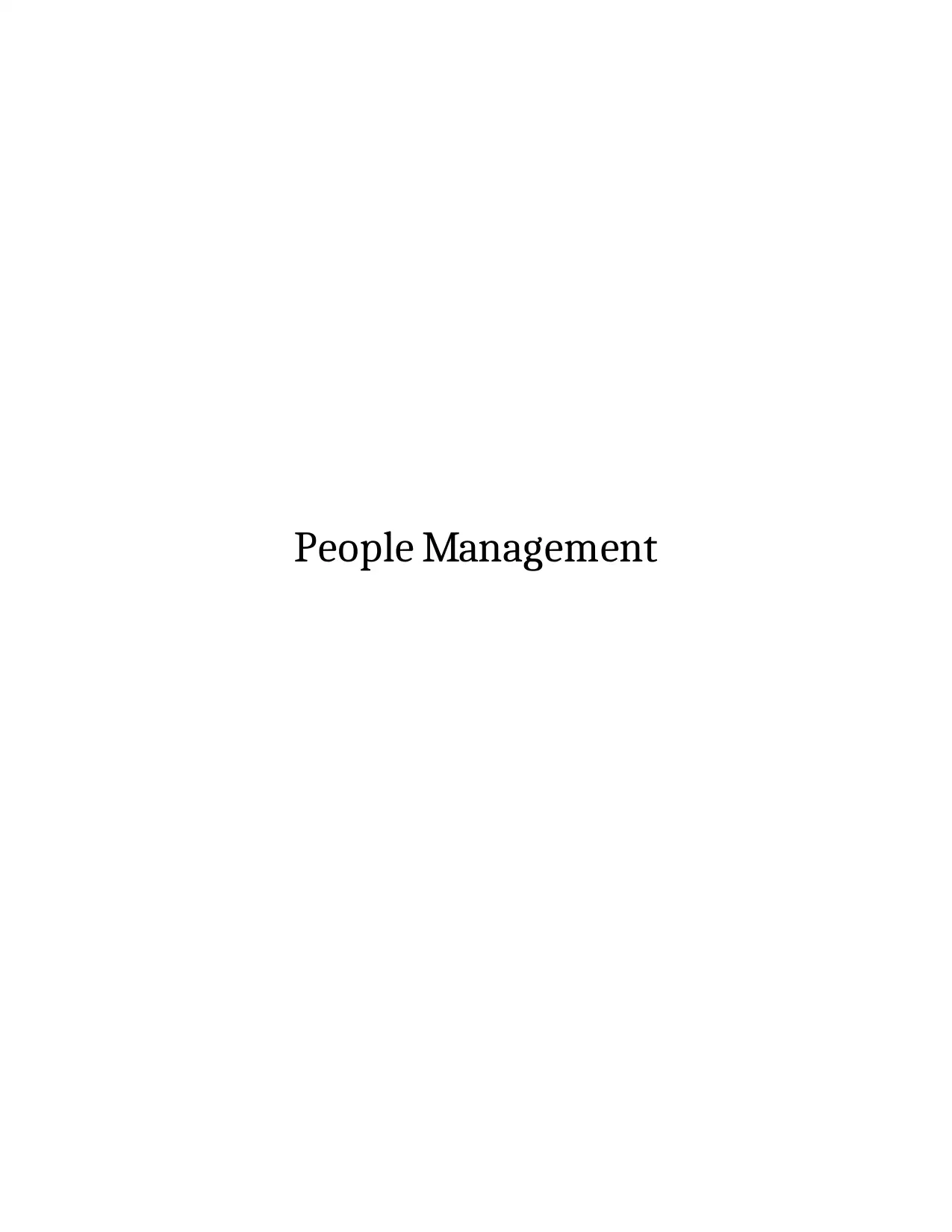
People Management
Paraphrase This Document
Need a fresh take? Get an instant paraphrase of this document with our AI Paraphraser
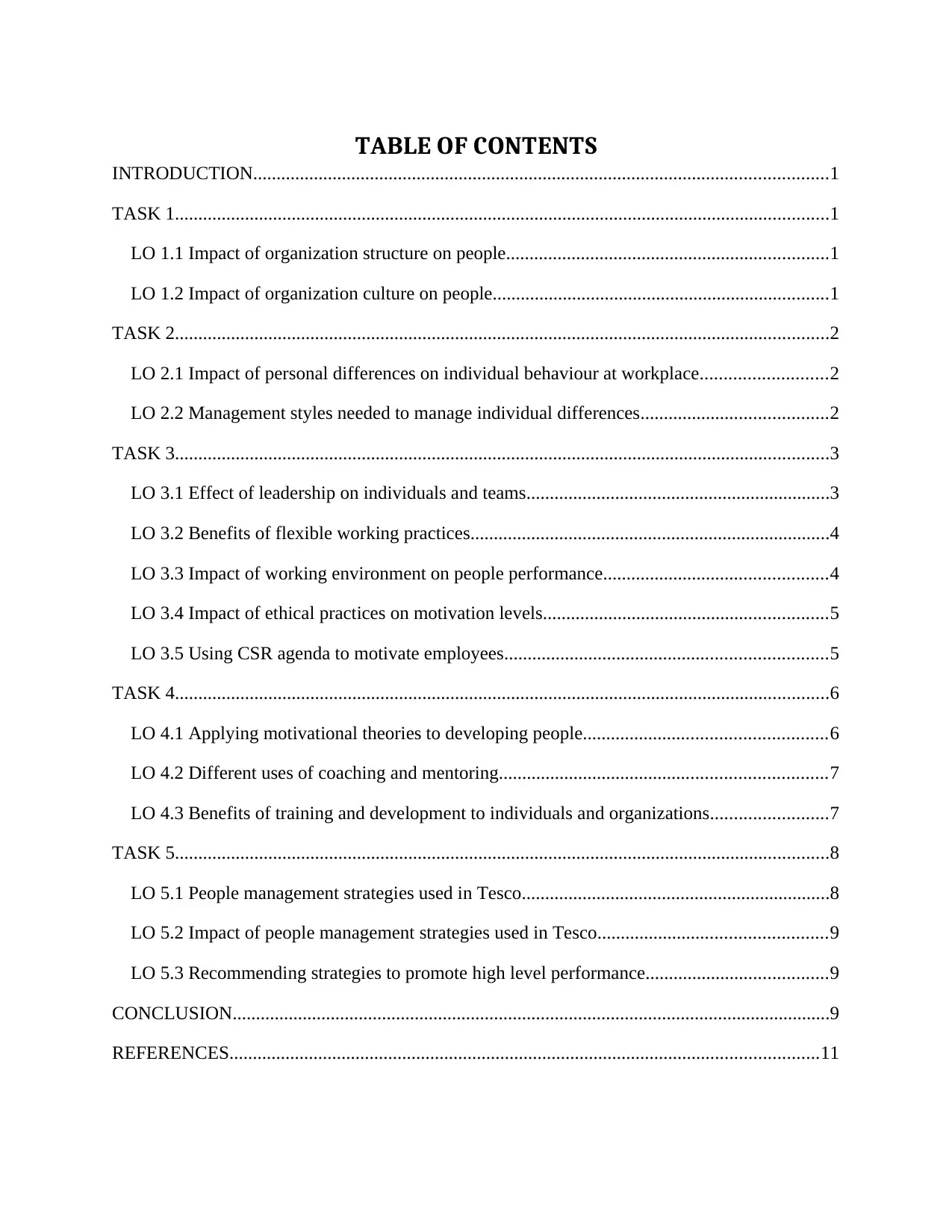
TABLE OF CONTENTS
INTRODUCTION...........................................................................................................................1
TASK 1............................................................................................................................................1
LO 1.1 Impact of organization structure on people.....................................................................1
LO 1.2 Impact of organization culture on people........................................................................1
TASK 2............................................................................................................................................2
LO 2.1 Impact of personal differences on individual behaviour at workplace...........................2
LO 2.2 Management styles needed to manage individual differences........................................2
TASK 3............................................................................................................................................3
LO 3.1 Effect of leadership on individuals and teams.................................................................3
LO 3.2 Benefits of flexible working practices.............................................................................4
LO 3.3 Impact of working environment on people performance................................................4
LO 3.4 Impact of ethical practices on motivation levels.............................................................5
LO 3.5 Using CSR agenda to motivate employees.....................................................................5
TASK 4............................................................................................................................................6
LO 4.1 Applying motivational theories to developing people....................................................6
LO 4.2 Different uses of coaching and mentoring......................................................................7
LO 4.3 Benefits of training and development to individuals and organizations.........................7
TASK 5............................................................................................................................................8
LO 5.1 People management strategies used in Tesco..................................................................8
LO 5.2 Impact of people management strategies used in Tesco.................................................9
LO 5.3 Recommending strategies to promote high level performance.......................................9
CONCLUSION................................................................................................................................9
REFERENCES..............................................................................................................................11
INTRODUCTION...........................................................................................................................1
TASK 1............................................................................................................................................1
LO 1.1 Impact of organization structure on people.....................................................................1
LO 1.2 Impact of organization culture on people........................................................................1
TASK 2............................................................................................................................................2
LO 2.1 Impact of personal differences on individual behaviour at workplace...........................2
LO 2.2 Management styles needed to manage individual differences........................................2
TASK 3............................................................................................................................................3
LO 3.1 Effect of leadership on individuals and teams.................................................................3
LO 3.2 Benefits of flexible working practices.............................................................................4
LO 3.3 Impact of working environment on people performance................................................4
LO 3.4 Impact of ethical practices on motivation levels.............................................................5
LO 3.5 Using CSR agenda to motivate employees.....................................................................5
TASK 4............................................................................................................................................6
LO 4.1 Applying motivational theories to developing people....................................................6
LO 4.2 Different uses of coaching and mentoring......................................................................7
LO 4.3 Benefits of training and development to individuals and organizations.........................7
TASK 5............................................................................................................................................8
LO 5.1 People management strategies used in Tesco..................................................................8
LO 5.2 Impact of people management strategies used in Tesco.................................................9
LO 5.3 Recommending strategies to promote high level performance.......................................9
CONCLUSION................................................................................................................................9
REFERENCES..............................................................................................................................11
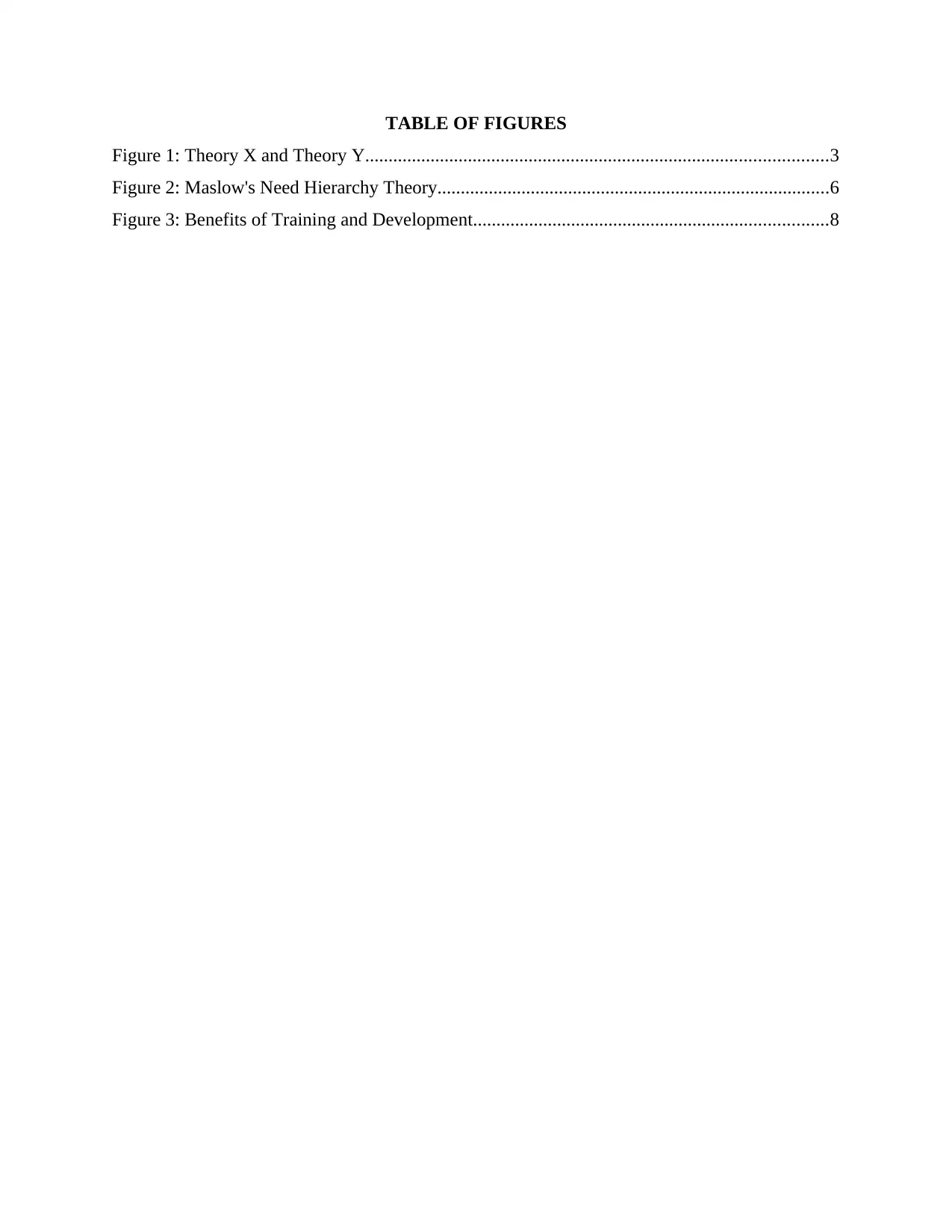
TABLE OF FIGURES
Figure 1: Theory X and Theory Y...................................................................................................3
Figure 2: Maslow's Need Hierarchy Theory....................................................................................6
Figure 3: Benefits of Training and Development............................................................................8
Figure 1: Theory X and Theory Y...................................................................................................3
Figure 2: Maslow's Need Hierarchy Theory....................................................................................6
Figure 3: Benefits of Training and Development............................................................................8
⊘ This is a preview!⊘
Do you want full access?
Subscribe today to unlock all pages.

Trusted by 1+ million students worldwide
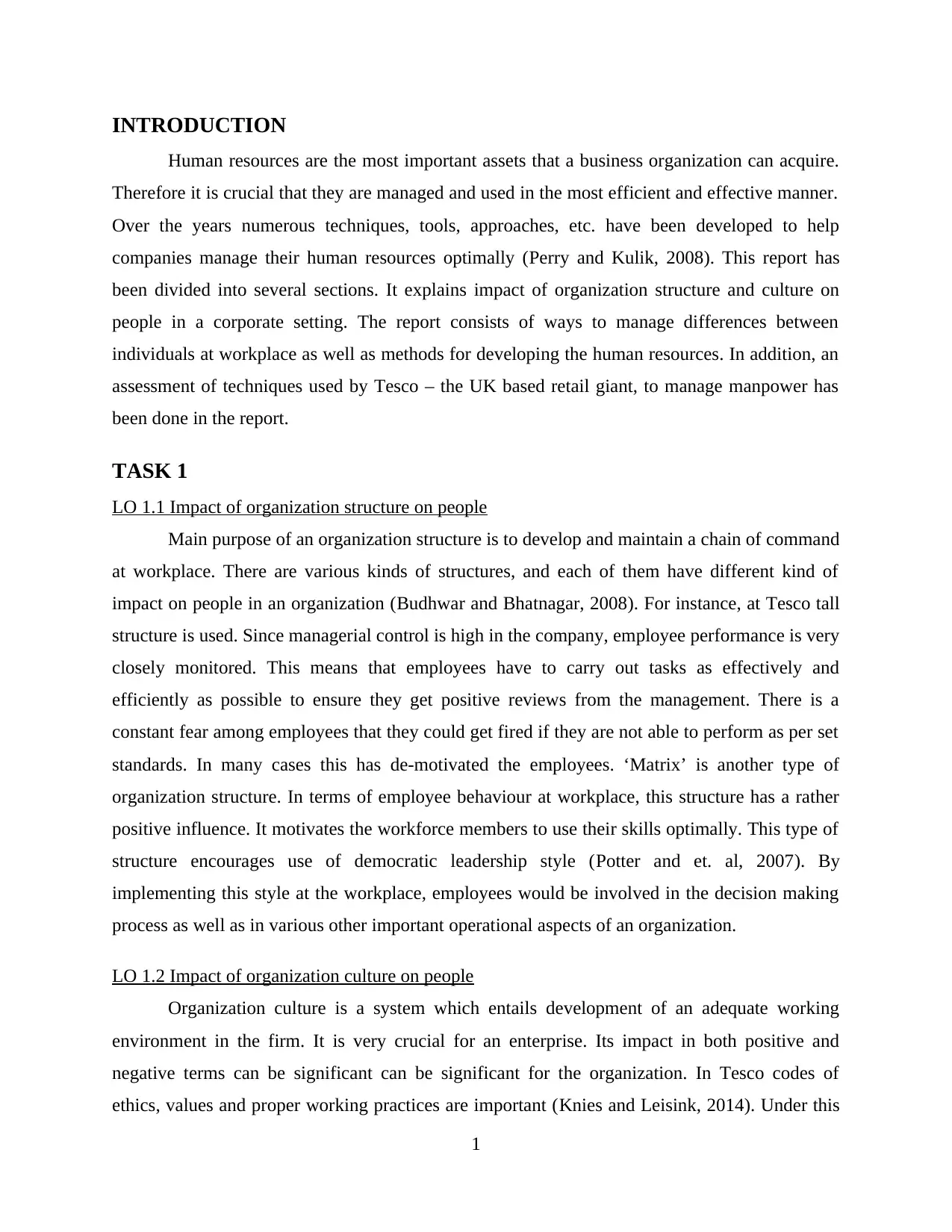
INTRODUCTION
Human resources are the most important assets that a business organization can acquire.
Therefore it is crucial that they are managed and used in the most efficient and effective manner.
Over the years numerous techniques, tools, approaches, etc. have been developed to help
companies manage their human resources optimally (Perry and Kulik, 2008). This report has
been divided into several sections. It explains impact of organization structure and culture on
people in a corporate setting. The report consists of ways to manage differences between
individuals at workplace as well as methods for developing the human resources. In addition, an
assessment of techniques used by Tesco – the UK based retail giant, to manage manpower has
been done in the report.
TASK 1
LO 1.1 Impact of organization structure on people
Main purpose of an organization structure is to develop and maintain a chain of command
at workplace. There are various kinds of structures, and each of them have different kind of
impact on people in an organization (Budhwar and Bhatnagar, 2008). For instance, at Tesco tall
structure is used. Since managerial control is high in the company, employee performance is very
closely monitored. This means that employees have to carry out tasks as effectively and
efficiently as possible to ensure they get positive reviews from the management. There is a
constant fear among employees that they could get fired if they are not able to perform as per set
standards. In many cases this has de-motivated the employees. ‘Matrix’ is another type of
organization structure. In terms of employee behaviour at workplace, this structure has a rather
positive influence. It motivates the workforce members to use their skills optimally. This type of
structure encourages use of democratic leadership style (Potter and et. al, 2007). By
implementing this style at the workplace, employees would be involved in the decision making
process as well as in various other important operational aspects of an organization.
LO 1.2 Impact of organization culture on people
Organization culture is a system which entails development of an adequate working
environment in the firm. It is very crucial for an enterprise. Its impact in both positive and
negative terms can be significant can be significant for the organization. In Tesco codes of
ethics, values and proper working practices are important (Knies and Leisink, 2014). Under this
1
Human resources are the most important assets that a business organization can acquire.
Therefore it is crucial that they are managed and used in the most efficient and effective manner.
Over the years numerous techniques, tools, approaches, etc. have been developed to help
companies manage their human resources optimally (Perry and Kulik, 2008). This report has
been divided into several sections. It explains impact of organization structure and culture on
people in a corporate setting. The report consists of ways to manage differences between
individuals at workplace as well as methods for developing the human resources. In addition, an
assessment of techniques used by Tesco – the UK based retail giant, to manage manpower has
been done in the report.
TASK 1
LO 1.1 Impact of organization structure on people
Main purpose of an organization structure is to develop and maintain a chain of command
at workplace. There are various kinds of structures, and each of them have different kind of
impact on people in an organization (Budhwar and Bhatnagar, 2008). For instance, at Tesco tall
structure is used. Since managerial control is high in the company, employee performance is very
closely monitored. This means that employees have to carry out tasks as effectively and
efficiently as possible to ensure they get positive reviews from the management. There is a
constant fear among employees that they could get fired if they are not able to perform as per set
standards. In many cases this has de-motivated the employees. ‘Matrix’ is another type of
organization structure. In terms of employee behaviour at workplace, this structure has a rather
positive influence. It motivates the workforce members to use their skills optimally. This type of
structure encourages use of democratic leadership style (Potter and et. al, 2007). By
implementing this style at the workplace, employees would be involved in the decision making
process as well as in various other important operational aspects of an organization.
LO 1.2 Impact of organization culture on people
Organization culture is a system which entails development of an adequate working
environment in the firm. It is very crucial for an enterprise. Its impact in both positive and
negative terms can be significant can be significant for the organization. In Tesco codes of
ethics, values and proper working practices are important (Knies and Leisink, 2014). Under this
1
Paraphrase This Document
Need a fresh take? Get an instant paraphrase of this document with our AI Paraphraser
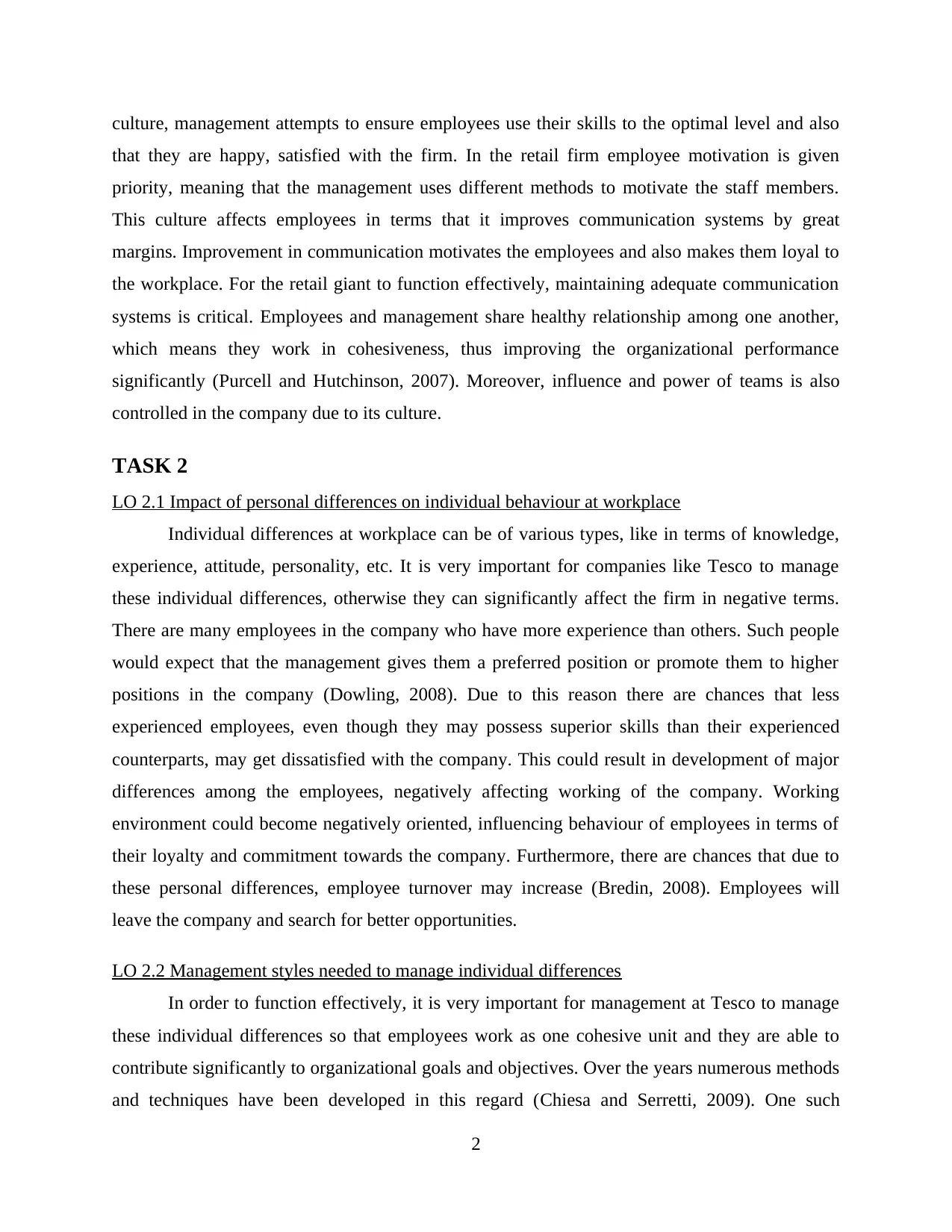
culture, management attempts to ensure employees use their skills to the optimal level and also
that they are happy, satisfied with the firm. In the retail firm employee motivation is given
priority, meaning that the management uses different methods to motivate the staff members.
This culture affects employees in terms that it improves communication systems by great
margins. Improvement in communication motivates the employees and also makes them loyal to
the workplace. For the retail giant to function effectively, maintaining adequate communication
systems is critical. Employees and management share healthy relationship among one another,
which means they work in cohesiveness, thus improving the organizational performance
significantly (Purcell and Hutchinson, 2007). Moreover, influence and power of teams is also
controlled in the company due to its culture.
TASK 2
LO 2.1 Impact of personal differences on individual behaviour at workplace
Individual differences at workplace can be of various types, like in terms of knowledge,
experience, attitude, personality, etc. It is very important for companies like Tesco to manage
these individual differences, otherwise they can significantly affect the firm in negative terms.
There are many employees in the company who have more experience than others. Such people
would expect that the management gives them a preferred position or promote them to higher
positions in the company (Dowling, 2008). Due to this reason there are chances that less
experienced employees, even though they may possess superior skills than their experienced
counterparts, may get dissatisfied with the company. This could result in development of major
differences among the employees, negatively affecting working of the company. Working
environment could become negatively oriented, influencing behaviour of employees in terms of
their loyalty and commitment towards the company. Furthermore, there are chances that due to
these personal differences, employee turnover may increase (Bredin, 2008). Employees will
leave the company and search for better opportunities.
LO 2.2 Management styles needed to manage individual differences
In order to function effectively, it is very important for management at Tesco to manage
these individual differences so that employees work as one cohesive unit and they are able to
contribute significantly to organizational goals and objectives. Over the years numerous methods
and techniques have been developed in this regard (Chiesa and Serretti, 2009). One such
2
that they are happy, satisfied with the firm. In the retail firm employee motivation is given
priority, meaning that the management uses different methods to motivate the staff members.
This culture affects employees in terms that it improves communication systems by great
margins. Improvement in communication motivates the employees and also makes them loyal to
the workplace. For the retail giant to function effectively, maintaining adequate communication
systems is critical. Employees and management share healthy relationship among one another,
which means they work in cohesiveness, thus improving the organizational performance
significantly (Purcell and Hutchinson, 2007). Moreover, influence and power of teams is also
controlled in the company due to its culture.
TASK 2
LO 2.1 Impact of personal differences on individual behaviour at workplace
Individual differences at workplace can be of various types, like in terms of knowledge,
experience, attitude, personality, etc. It is very important for companies like Tesco to manage
these individual differences, otherwise they can significantly affect the firm in negative terms.
There are many employees in the company who have more experience than others. Such people
would expect that the management gives them a preferred position or promote them to higher
positions in the company (Dowling, 2008). Due to this reason there are chances that less
experienced employees, even though they may possess superior skills than their experienced
counterparts, may get dissatisfied with the company. This could result in development of major
differences among the employees, negatively affecting working of the company. Working
environment could become negatively oriented, influencing behaviour of employees in terms of
their loyalty and commitment towards the company. Furthermore, there are chances that due to
these personal differences, employee turnover may increase (Bredin, 2008). Employees will
leave the company and search for better opportunities.
LO 2.2 Management styles needed to manage individual differences
In order to function effectively, it is very important for management at Tesco to manage
these individual differences so that employees work as one cohesive unit and they are able to
contribute significantly to organizational goals and objectives. Over the years numerous methods
and techniques have been developed in this regard (Chiesa and Serretti, 2009). One such
2
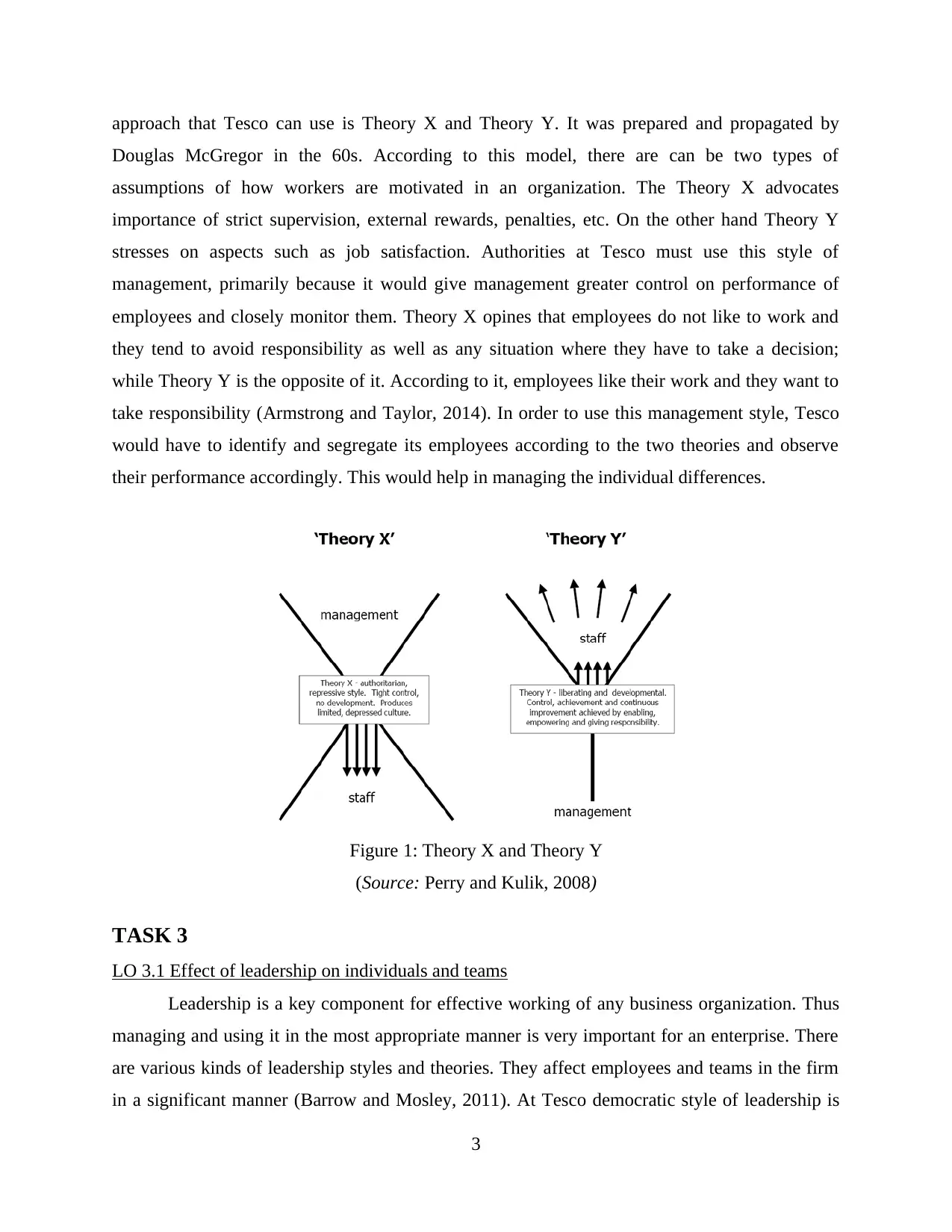
approach that Tesco can use is Theory X and Theory Y. It was prepared and propagated by
Douglas McGregor in the 60s. According to this model, there are can be two types of
assumptions of how workers are motivated in an organization. The Theory X advocates
importance of strict supervision, external rewards, penalties, etc. On the other hand Theory Y
stresses on aspects such as job satisfaction. Authorities at Tesco must use this style of
management, primarily because it would give management greater control on performance of
employees and closely monitor them. Theory X opines that employees do not like to work and
they tend to avoid responsibility as well as any situation where they have to take a decision;
while Theory Y is the opposite of it. According to it, employees like their work and they want to
take responsibility (Armstrong and Taylor, 2014). In order to use this management style, Tesco
would have to identify and segregate its employees according to the two theories and observe
their performance accordingly. This would help in managing the individual differences.
Figure 1: Theory X and Theory Y
(Source: Perry and Kulik, 2008)
TASK 3
LO 3.1 Effect of leadership on individuals and teams
Leadership is a key component for effective working of any business organization. Thus
managing and using it in the most appropriate manner is very important for an enterprise. There
are various kinds of leadership styles and theories. They affect employees and teams in the firm
in a significant manner (Barrow and Mosley, 2011). At Tesco democratic style of leadership is
3
Douglas McGregor in the 60s. According to this model, there are can be two types of
assumptions of how workers are motivated in an organization. The Theory X advocates
importance of strict supervision, external rewards, penalties, etc. On the other hand Theory Y
stresses on aspects such as job satisfaction. Authorities at Tesco must use this style of
management, primarily because it would give management greater control on performance of
employees and closely monitor them. Theory X opines that employees do not like to work and
they tend to avoid responsibility as well as any situation where they have to take a decision;
while Theory Y is the opposite of it. According to it, employees like their work and they want to
take responsibility (Armstrong and Taylor, 2014). In order to use this management style, Tesco
would have to identify and segregate its employees according to the two theories and observe
their performance accordingly. This would help in managing the individual differences.
Figure 1: Theory X and Theory Y
(Source: Perry and Kulik, 2008)
TASK 3
LO 3.1 Effect of leadership on individuals and teams
Leadership is a key component for effective working of any business organization. Thus
managing and using it in the most appropriate manner is very important for an enterprise. There
are various kinds of leadership styles and theories. They affect employees and teams in the firm
in a significant manner (Barrow and Mosley, 2011). At Tesco democratic style of leadership is
3
⊘ This is a preview!⊘
Do you want full access?
Subscribe today to unlock all pages.

Trusted by 1+ million students worldwide
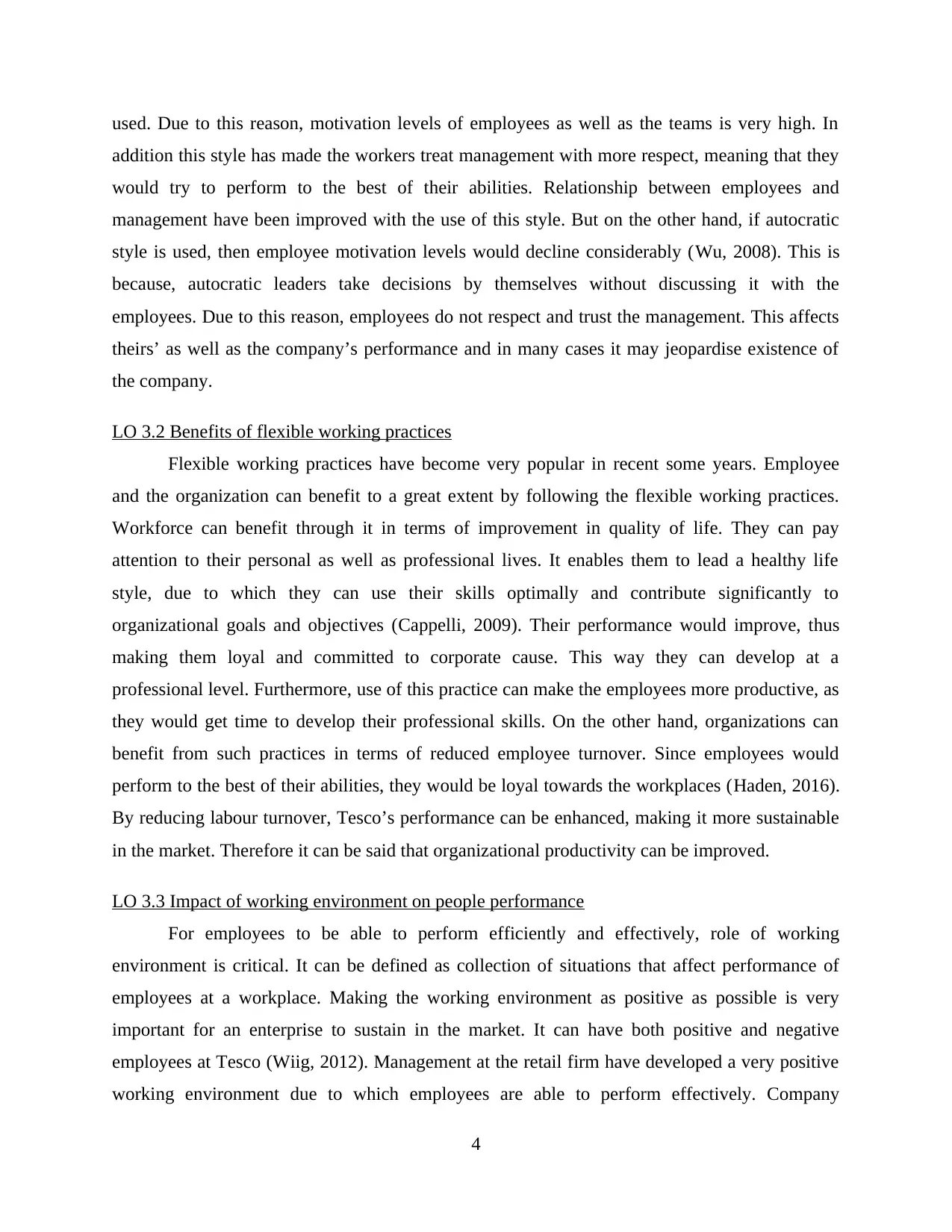
used. Due to this reason, motivation levels of employees as well as the teams is very high. In
addition this style has made the workers treat management with more respect, meaning that they
would try to perform to the best of their abilities. Relationship between employees and
management have been improved with the use of this style. But on the other hand, if autocratic
style is used, then employee motivation levels would decline considerably (Wu, 2008). This is
because, autocratic leaders take decisions by themselves without discussing it with the
employees. Due to this reason, employees do not respect and trust the management. This affects
theirs’ as well as the company’s performance and in many cases it may jeopardise existence of
the company.
LO 3.2 Benefits of flexible working practices
Flexible working practices have become very popular in recent some years. Employee
and the organization can benefit to a great extent by following the flexible working practices.
Workforce can benefit through it in terms of improvement in quality of life. They can pay
attention to their personal as well as professional lives. It enables them to lead a healthy life
style, due to which they can use their skills optimally and contribute significantly to
organizational goals and objectives (Cappelli, 2009). Their performance would improve, thus
making them loyal and committed to corporate cause. This way they can develop at a
professional level. Furthermore, use of this practice can make the employees more productive, as
they would get time to develop their professional skills. On the other hand, organizations can
benefit from such practices in terms of reduced employee turnover. Since employees would
perform to the best of their abilities, they would be loyal towards the workplaces (Haden, 2016).
By reducing labour turnover, Tesco’s performance can be enhanced, making it more sustainable
in the market. Therefore it can be said that organizational productivity can be improved.
LO 3.3 Impact of working environment on people performance
For employees to be able to perform efficiently and effectively, role of working
environment is critical. It can be defined as collection of situations that affect performance of
employees at a workplace. Making the working environment as positive as possible is very
important for an enterprise to sustain in the market. It can have both positive and negative
employees at Tesco (Wiig, 2012). Management at the retail firm have developed a very positive
working environment due to which employees are able to perform effectively. Company
4
addition this style has made the workers treat management with more respect, meaning that they
would try to perform to the best of their abilities. Relationship between employees and
management have been improved with the use of this style. But on the other hand, if autocratic
style is used, then employee motivation levels would decline considerably (Wu, 2008). This is
because, autocratic leaders take decisions by themselves without discussing it with the
employees. Due to this reason, employees do not respect and trust the management. This affects
theirs’ as well as the company’s performance and in many cases it may jeopardise existence of
the company.
LO 3.2 Benefits of flexible working practices
Flexible working practices have become very popular in recent some years. Employee
and the organization can benefit to a great extent by following the flexible working practices.
Workforce can benefit through it in terms of improvement in quality of life. They can pay
attention to their personal as well as professional lives. It enables them to lead a healthy life
style, due to which they can use their skills optimally and contribute significantly to
organizational goals and objectives (Cappelli, 2009). Their performance would improve, thus
making them loyal and committed to corporate cause. This way they can develop at a
professional level. Furthermore, use of this practice can make the employees more productive, as
they would get time to develop their professional skills. On the other hand, organizations can
benefit from such practices in terms of reduced employee turnover. Since employees would
perform to the best of their abilities, they would be loyal towards the workplaces (Haden, 2016).
By reducing labour turnover, Tesco’s performance can be enhanced, making it more sustainable
in the market. Therefore it can be said that organizational productivity can be improved.
LO 3.3 Impact of working environment on people performance
For employees to be able to perform efficiently and effectively, role of working
environment is critical. It can be defined as collection of situations that affect performance of
employees at a workplace. Making the working environment as positive as possible is very
important for an enterprise to sustain in the market. It can have both positive and negative
employees at Tesco (Wiig, 2012). Management at the retail firm have developed a very positive
working environment due to which employees are able to perform effectively. Company
4
Paraphrase This Document
Need a fresh take? Get an instant paraphrase of this document with our AI Paraphraser
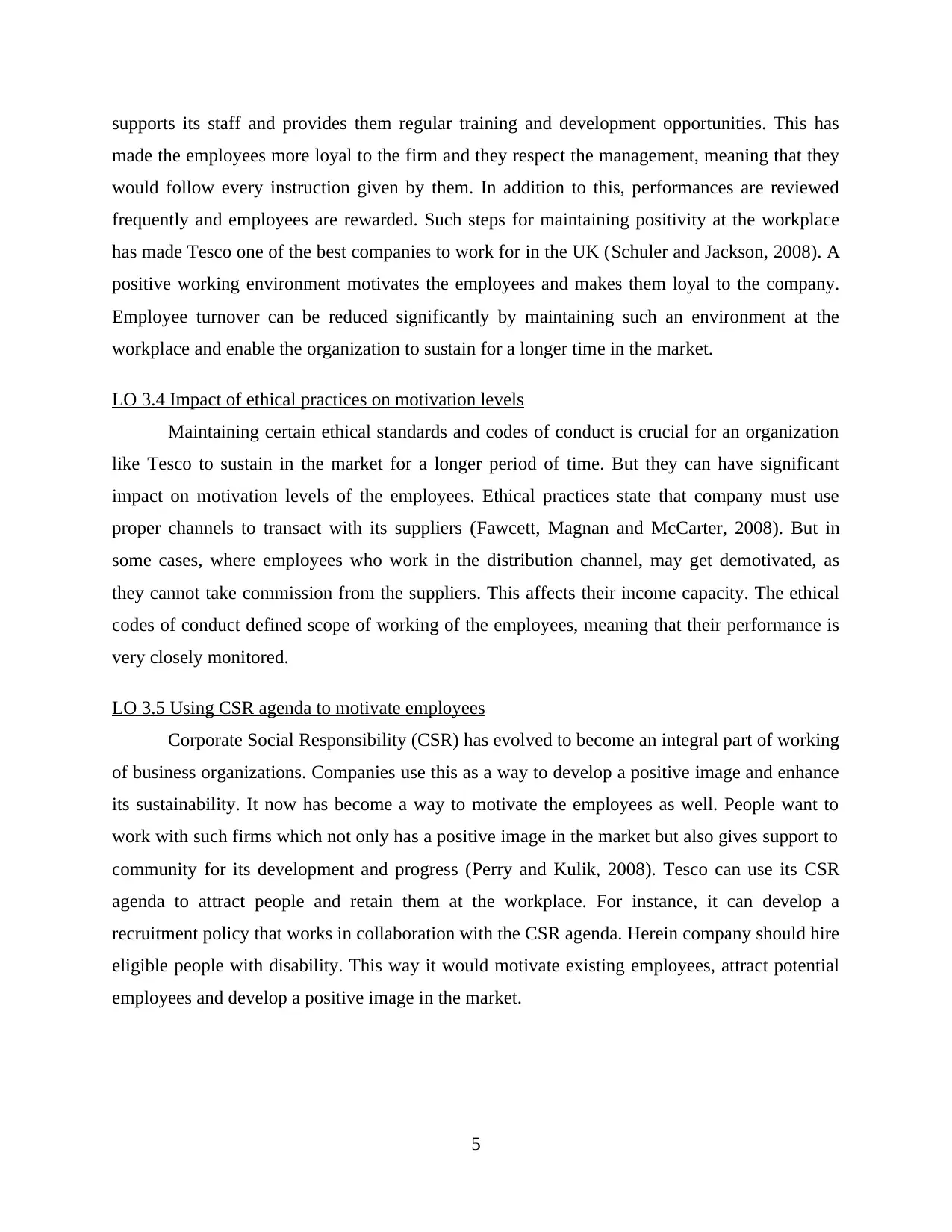
supports its staff and provides them regular training and development opportunities. This has
made the employees more loyal to the firm and they respect the management, meaning that they
would follow every instruction given by them. In addition to this, performances are reviewed
frequently and employees are rewarded. Such steps for maintaining positivity at the workplace
has made Tesco one of the best companies to work for in the UK (Schuler and Jackson, 2008). A
positive working environment motivates the employees and makes them loyal to the company.
Employee turnover can be reduced significantly by maintaining such an environment at the
workplace and enable the organization to sustain for a longer time in the market.
LO 3.4 Impact of ethical practices on motivation levels
Maintaining certain ethical standards and codes of conduct is crucial for an organization
like Tesco to sustain in the market for a longer period of time. But they can have significant
impact on motivation levels of the employees. Ethical practices state that company must use
proper channels to transact with its suppliers (Fawcett, Magnan and McCarter, 2008). But in
some cases, where employees who work in the distribution channel, may get demotivated, as
they cannot take commission from the suppliers. This affects their income capacity. The ethical
codes of conduct defined scope of working of the employees, meaning that their performance is
very closely monitored.
LO 3.5 Using CSR agenda to motivate employees
Corporate Social Responsibility (CSR) has evolved to become an integral part of working
of business organizations. Companies use this as a way to develop a positive image and enhance
its sustainability. It now has become a way to motivate the employees as well. People want to
work with such firms which not only has a positive image in the market but also gives support to
community for its development and progress (Perry and Kulik, 2008). Tesco can use its CSR
agenda to attract people and retain them at the workplace. For instance, it can develop a
recruitment policy that works in collaboration with the CSR agenda. Herein company should hire
eligible people with disability. This way it would motivate existing employees, attract potential
employees and develop a positive image in the market.
5
made the employees more loyal to the firm and they respect the management, meaning that they
would follow every instruction given by them. In addition to this, performances are reviewed
frequently and employees are rewarded. Such steps for maintaining positivity at the workplace
has made Tesco one of the best companies to work for in the UK (Schuler and Jackson, 2008). A
positive working environment motivates the employees and makes them loyal to the company.
Employee turnover can be reduced significantly by maintaining such an environment at the
workplace and enable the organization to sustain for a longer time in the market.
LO 3.4 Impact of ethical practices on motivation levels
Maintaining certain ethical standards and codes of conduct is crucial for an organization
like Tesco to sustain in the market for a longer period of time. But they can have significant
impact on motivation levels of the employees. Ethical practices state that company must use
proper channels to transact with its suppliers (Fawcett, Magnan and McCarter, 2008). But in
some cases, where employees who work in the distribution channel, may get demotivated, as
they cannot take commission from the suppliers. This affects their income capacity. The ethical
codes of conduct defined scope of working of the employees, meaning that their performance is
very closely monitored.
LO 3.5 Using CSR agenda to motivate employees
Corporate Social Responsibility (CSR) has evolved to become an integral part of working
of business organizations. Companies use this as a way to develop a positive image and enhance
its sustainability. It now has become a way to motivate the employees as well. People want to
work with such firms which not only has a positive image in the market but also gives support to
community for its development and progress (Perry and Kulik, 2008). Tesco can use its CSR
agenda to attract people and retain them at the workplace. For instance, it can develop a
recruitment policy that works in collaboration with the CSR agenda. Herein company should hire
eligible people with disability. This way it would motivate existing employees, attract potential
employees and develop a positive image in the market.
5
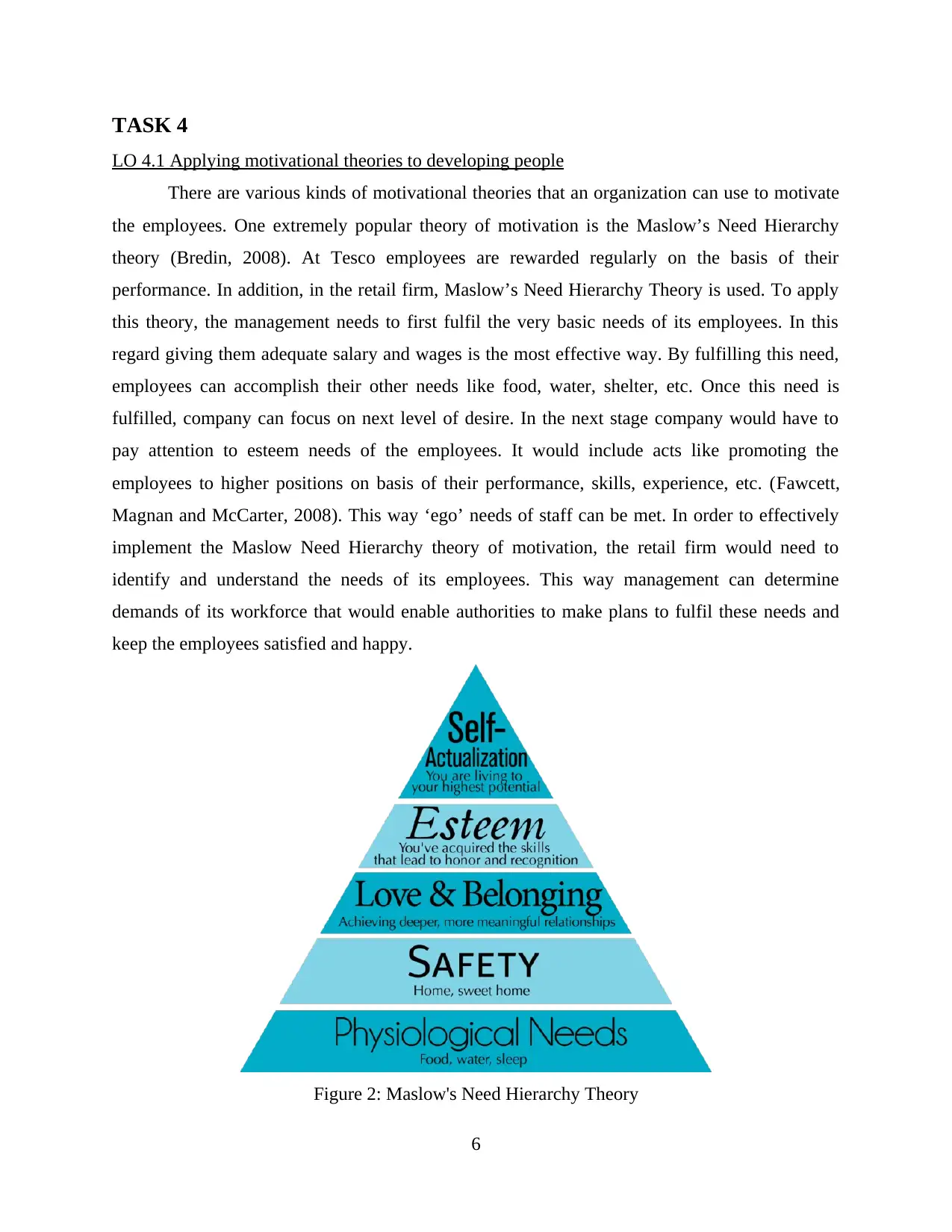
TASK 4
LO 4.1 Applying motivational theories to developing people
There are various kinds of motivational theories that an organization can use to motivate
the employees. One extremely popular theory of motivation is the Maslow’s Need Hierarchy
theory (Bredin, 2008). At Tesco employees are rewarded regularly on the basis of their
performance. In addition, in the retail firm, Maslow’s Need Hierarchy Theory is used. To apply
this theory, the management needs to first fulfil the very basic needs of its employees. In this
regard giving them adequate salary and wages is the most effective way. By fulfilling this need,
employees can accomplish their other needs like food, water, shelter, etc. Once this need is
fulfilled, company can focus on next level of desire. In the next stage company would have to
pay attention to esteem needs of the employees. It would include acts like promoting the
employees to higher positions on basis of their performance, skills, experience, etc. (Fawcett,
Magnan and McCarter, 2008). This way ‘ego’ needs of staff can be met. In order to effectively
implement the Maslow Need Hierarchy theory of motivation, the retail firm would need to
identify and understand the needs of its employees. This way management can determine
demands of its workforce that would enable authorities to make plans to fulfil these needs and
keep the employees satisfied and happy.
Figure 2: Maslow's Need Hierarchy Theory
6
LO 4.1 Applying motivational theories to developing people
There are various kinds of motivational theories that an organization can use to motivate
the employees. One extremely popular theory of motivation is the Maslow’s Need Hierarchy
theory (Bredin, 2008). At Tesco employees are rewarded regularly on the basis of their
performance. In addition, in the retail firm, Maslow’s Need Hierarchy Theory is used. To apply
this theory, the management needs to first fulfil the very basic needs of its employees. In this
regard giving them adequate salary and wages is the most effective way. By fulfilling this need,
employees can accomplish their other needs like food, water, shelter, etc. Once this need is
fulfilled, company can focus on next level of desire. In the next stage company would have to
pay attention to esteem needs of the employees. It would include acts like promoting the
employees to higher positions on basis of their performance, skills, experience, etc. (Fawcett,
Magnan and McCarter, 2008). This way ‘ego’ needs of staff can be met. In order to effectively
implement the Maslow Need Hierarchy theory of motivation, the retail firm would need to
identify and understand the needs of its employees. This way management can determine
demands of its workforce that would enable authorities to make plans to fulfil these needs and
keep the employees satisfied and happy.
Figure 2: Maslow's Need Hierarchy Theory
6
⊘ This is a preview!⊘
Do you want full access?
Subscribe today to unlock all pages.

Trusted by 1+ million students worldwide
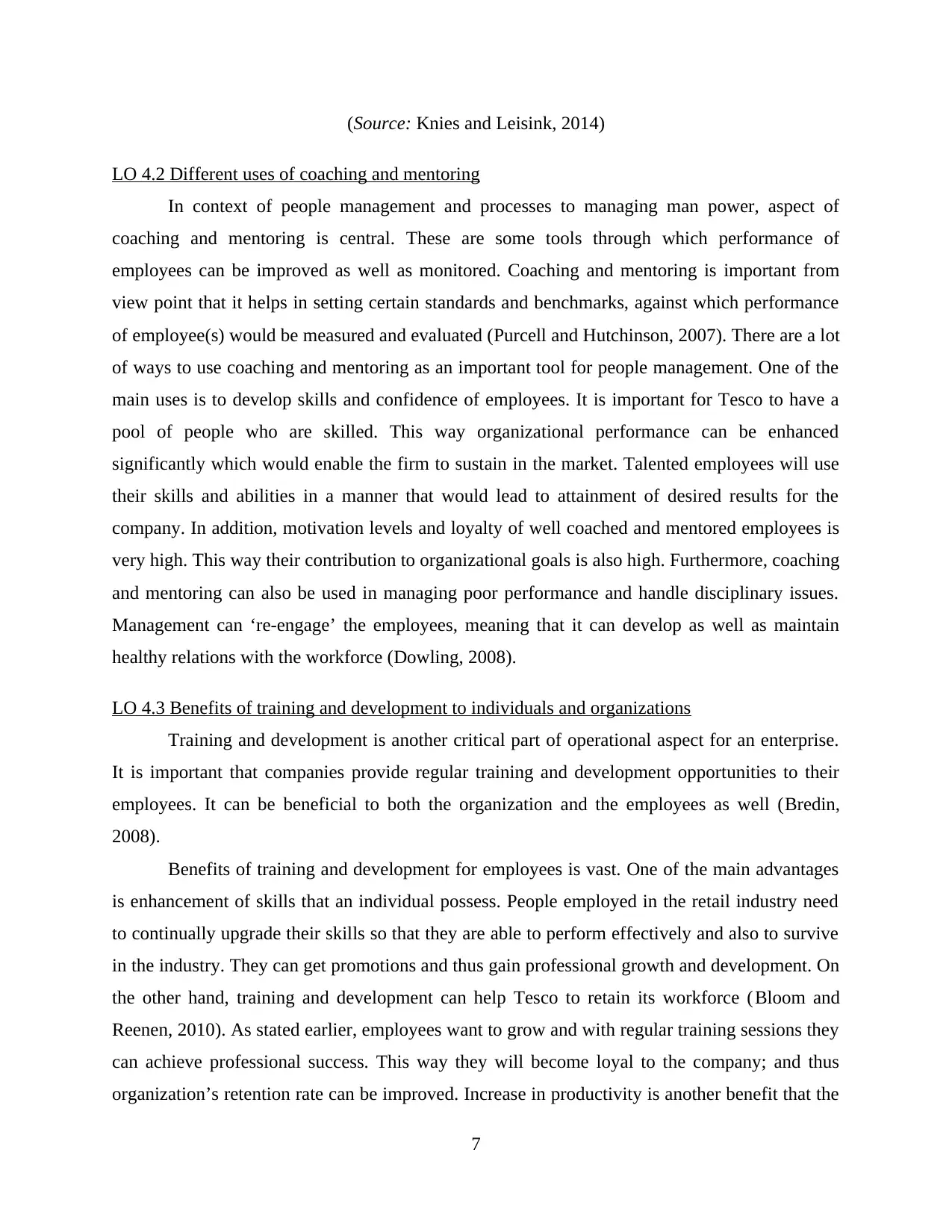
(Source: Knies and Leisink, 2014)
LO 4.2 Different uses of coaching and mentoring
In context of people management and processes to managing man power, aspect of
coaching and mentoring is central. These are some tools through which performance of
employees can be improved as well as monitored. Coaching and mentoring is important from
view point that it helps in setting certain standards and benchmarks, against which performance
of employee(s) would be measured and evaluated (Purcell and Hutchinson, 2007). There are a lot
of ways to use coaching and mentoring as an important tool for people management. One of the
main uses is to develop skills and confidence of employees. It is important for Tesco to have a
pool of people who are skilled. This way organizational performance can be enhanced
significantly which would enable the firm to sustain in the market. Talented employees will use
their skills and abilities in a manner that would lead to attainment of desired results for the
company. In addition, motivation levels and loyalty of well coached and mentored employees is
very high. This way their contribution to organizational goals is also high. Furthermore, coaching
and mentoring can also be used in managing poor performance and handle disciplinary issues.
Management can ‘re-engage’ the employees, meaning that it can develop as well as maintain
healthy relations with the workforce (Dowling, 2008).
LO 4.3 Benefits of training and development to individuals and organizations
Training and development is another critical part of operational aspect for an enterprise.
It is important that companies provide regular training and development opportunities to their
employees. It can be beneficial to both the organization and the employees as well (Bredin,
2008).
Benefits of training and development for employees is vast. One of the main advantages
is enhancement of skills that an individual possess. People employed in the retail industry need
to continually upgrade their skills so that they are able to perform effectively and also to survive
in the industry. They can get promotions and thus gain professional growth and development. On
the other hand, training and development can help Tesco to retain its workforce (Bloom and
Reenen, 2010). As stated earlier, employees want to grow and with regular training sessions they
can achieve professional success. This way they will become loyal to the company; and thus
organization’s retention rate can be improved. Increase in productivity is another benefit that the
7
LO 4.2 Different uses of coaching and mentoring
In context of people management and processes to managing man power, aspect of
coaching and mentoring is central. These are some tools through which performance of
employees can be improved as well as monitored. Coaching and mentoring is important from
view point that it helps in setting certain standards and benchmarks, against which performance
of employee(s) would be measured and evaluated (Purcell and Hutchinson, 2007). There are a lot
of ways to use coaching and mentoring as an important tool for people management. One of the
main uses is to develop skills and confidence of employees. It is important for Tesco to have a
pool of people who are skilled. This way organizational performance can be enhanced
significantly which would enable the firm to sustain in the market. Talented employees will use
their skills and abilities in a manner that would lead to attainment of desired results for the
company. In addition, motivation levels and loyalty of well coached and mentored employees is
very high. This way their contribution to organizational goals is also high. Furthermore, coaching
and mentoring can also be used in managing poor performance and handle disciplinary issues.
Management can ‘re-engage’ the employees, meaning that it can develop as well as maintain
healthy relations with the workforce (Dowling, 2008).
LO 4.3 Benefits of training and development to individuals and organizations
Training and development is another critical part of operational aspect for an enterprise.
It is important that companies provide regular training and development opportunities to their
employees. It can be beneficial to both the organization and the employees as well (Bredin,
2008).
Benefits of training and development for employees is vast. One of the main advantages
is enhancement of skills that an individual possess. People employed in the retail industry need
to continually upgrade their skills so that they are able to perform effectively and also to survive
in the industry. They can get promotions and thus gain professional growth and development. On
the other hand, training and development can help Tesco to retain its workforce (Bloom and
Reenen, 2010). As stated earlier, employees want to grow and with regular training sessions they
can achieve professional success. This way they will become loyal to the company; and thus
organization’s retention rate can be improved. Increase in productivity is another benefit that the
7
Paraphrase This Document
Need a fresh take? Get an instant paraphrase of this document with our AI Paraphraser
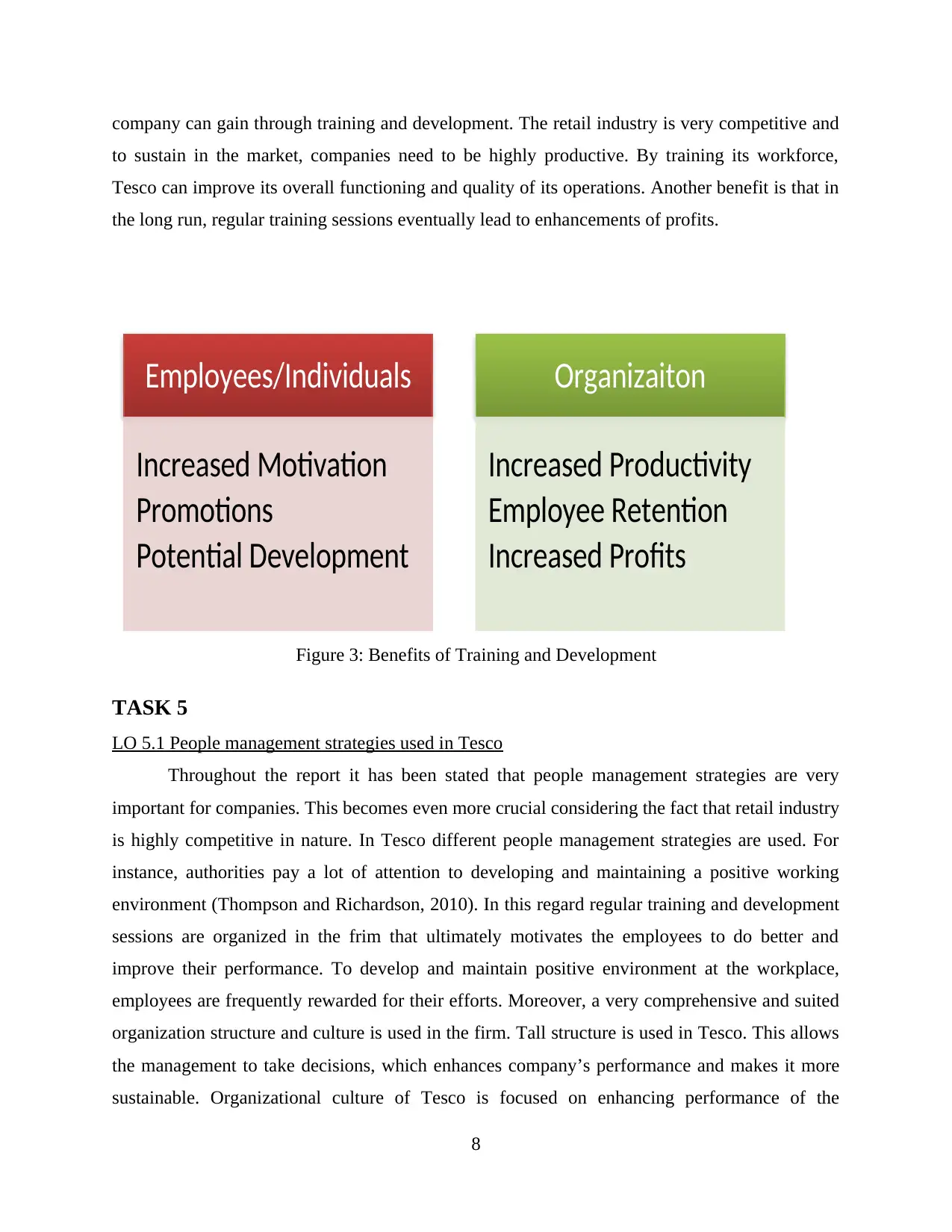
company can gain through training and development. The retail industry is very competitive and
to sustain in the market, companies need to be highly productive. By training its workforce,
Tesco can improve its overall functioning and quality of its operations. Another benefit is that in
the long run, regular training sessions eventually lead to enhancements of profits.
Figure 3: Benefits of Training and Development
TASK 5
LO 5.1 People management strategies used in Tesco
Throughout the report it has been stated that people management strategies are very
important for companies. This becomes even more crucial considering the fact that retail industry
is highly competitive in nature. In Tesco different people management strategies are used. For
instance, authorities pay a lot of attention to developing and maintaining a positive working
environment (Thompson and Richardson, 2010). In this regard regular training and development
sessions are organized in the frim that ultimately motivates the employees to do better and
improve their performance. To develop and maintain positive environment at the workplace,
employees are frequently rewarded for their efforts. Moreover, a very comprehensive and suited
organization structure and culture is used in the firm. Tall structure is used in Tesco. This allows
the management to take decisions, which enhances company’s performance and makes it more
sustainable. Organizational culture of Tesco is focused on enhancing performance of the
8
Employees/Individuals
Increased Motivation
Promotions
Potential Development
Organizaiton
Increased Productivity
Employee Retention
Increased Profits
to sustain in the market, companies need to be highly productive. By training its workforce,
Tesco can improve its overall functioning and quality of its operations. Another benefit is that in
the long run, regular training sessions eventually lead to enhancements of profits.
Figure 3: Benefits of Training and Development
TASK 5
LO 5.1 People management strategies used in Tesco
Throughout the report it has been stated that people management strategies are very
important for companies. This becomes even more crucial considering the fact that retail industry
is highly competitive in nature. In Tesco different people management strategies are used. For
instance, authorities pay a lot of attention to developing and maintaining a positive working
environment (Thompson and Richardson, 2010). In this regard regular training and development
sessions are organized in the frim that ultimately motivates the employees to do better and
improve their performance. To develop and maintain positive environment at the workplace,
employees are frequently rewarded for their efforts. Moreover, a very comprehensive and suited
organization structure and culture is used in the firm. Tall structure is used in Tesco. This allows
the management to take decisions, which enhances company’s performance and makes it more
sustainable. Organizational culture of Tesco is focused on enhancing performance of the
8
Employees/Individuals
Increased Motivation
Promotions
Potential Development
Organizaiton
Increased Productivity
Employee Retention
Increased Profits
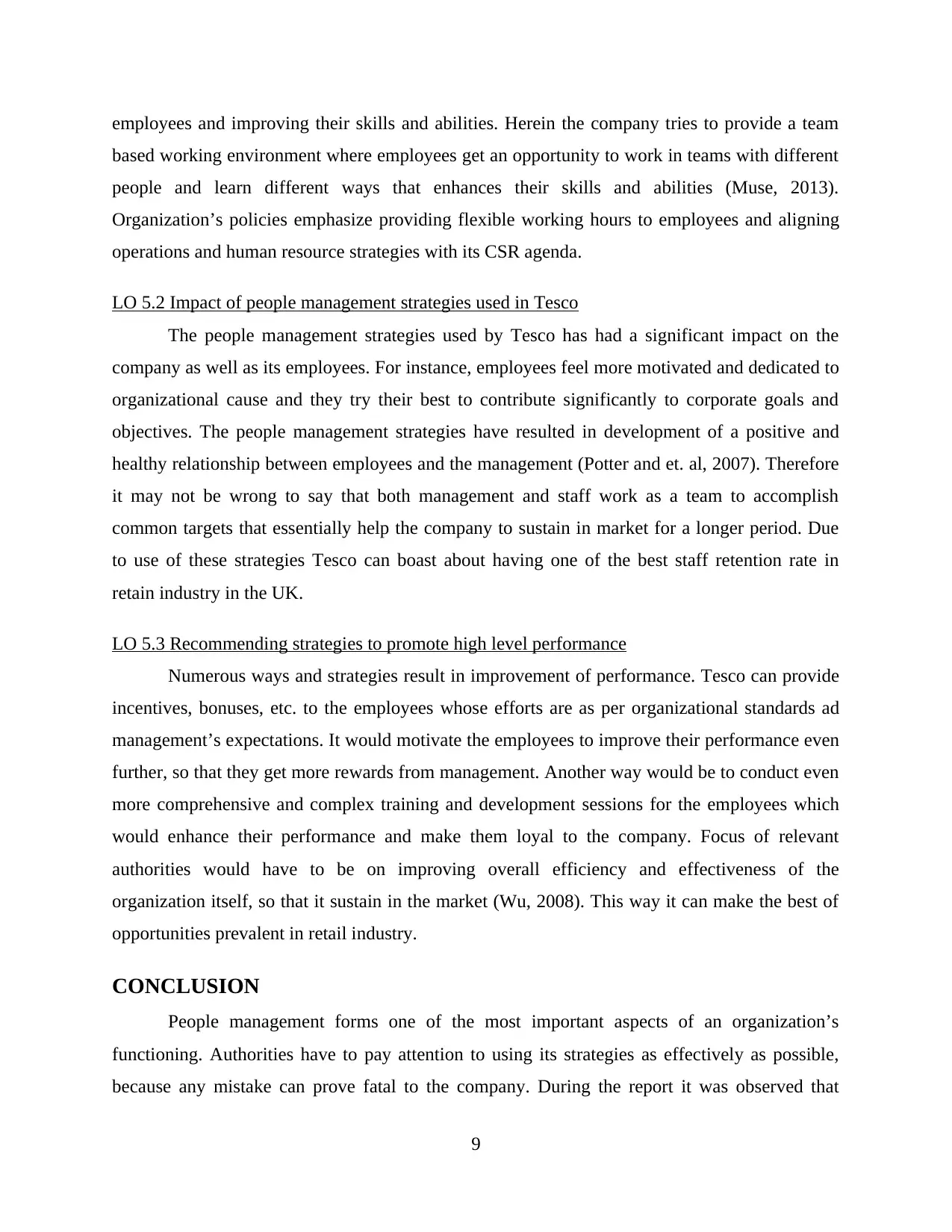
employees and improving their skills and abilities. Herein the company tries to provide a team
based working environment where employees get an opportunity to work in teams with different
people and learn different ways that enhances their skills and abilities (Muse, 2013).
Organization’s policies emphasize providing flexible working hours to employees and aligning
operations and human resource strategies with its CSR agenda.
LO 5.2 Impact of people management strategies used in Tesco
The people management strategies used by Tesco has had a significant impact on the
company as well as its employees. For instance, employees feel more motivated and dedicated to
organizational cause and they try their best to contribute significantly to corporate goals and
objectives. The people management strategies have resulted in development of a positive and
healthy relationship between employees and the management (Potter and et. al, 2007). Therefore
it may not be wrong to say that both management and staff work as a team to accomplish
common targets that essentially help the company to sustain in market for a longer period. Due
to use of these strategies Tesco can boast about having one of the best staff retention rate in
retain industry in the UK.
LO 5.3 Recommending strategies to promote high level performance
Numerous ways and strategies result in improvement of performance. Tesco can provide
incentives, bonuses, etc. to the employees whose efforts are as per organizational standards ad
management’s expectations. It would motivate the employees to improve their performance even
further, so that they get more rewards from management. Another way would be to conduct even
more comprehensive and complex training and development sessions for the employees which
would enhance their performance and make them loyal to the company. Focus of relevant
authorities would have to be on improving overall efficiency and effectiveness of the
organization itself, so that it sustain in the market (Wu, 2008). This way it can make the best of
opportunities prevalent in retail industry.
CONCLUSION
People management forms one of the most important aspects of an organization’s
functioning. Authorities have to pay attention to using its strategies as effectively as possible,
because any mistake can prove fatal to the company. During the report it was observed that
9
based working environment where employees get an opportunity to work in teams with different
people and learn different ways that enhances their skills and abilities (Muse, 2013).
Organization’s policies emphasize providing flexible working hours to employees and aligning
operations and human resource strategies with its CSR agenda.
LO 5.2 Impact of people management strategies used in Tesco
The people management strategies used by Tesco has had a significant impact on the
company as well as its employees. For instance, employees feel more motivated and dedicated to
organizational cause and they try their best to contribute significantly to corporate goals and
objectives. The people management strategies have resulted in development of a positive and
healthy relationship between employees and the management (Potter and et. al, 2007). Therefore
it may not be wrong to say that both management and staff work as a team to accomplish
common targets that essentially help the company to sustain in market for a longer period. Due
to use of these strategies Tesco can boast about having one of the best staff retention rate in
retain industry in the UK.
LO 5.3 Recommending strategies to promote high level performance
Numerous ways and strategies result in improvement of performance. Tesco can provide
incentives, bonuses, etc. to the employees whose efforts are as per organizational standards ad
management’s expectations. It would motivate the employees to improve their performance even
further, so that they get more rewards from management. Another way would be to conduct even
more comprehensive and complex training and development sessions for the employees which
would enhance their performance and make them loyal to the company. Focus of relevant
authorities would have to be on improving overall efficiency and effectiveness of the
organization itself, so that it sustain in the market (Wu, 2008). This way it can make the best of
opportunities prevalent in retail industry.
CONCLUSION
People management forms one of the most important aspects of an organization’s
functioning. Authorities have to pay attention to using its strategies as effectively as possible,
because any mistake can prove fatal to the company. During the report it was observed that
9
⊘ This is a preview!⊘
Do you want full access?
Subscribe today to unlock all pages.

Trusted by 1+ million students worldwide
1 out of 15
Related Documents
Your All-in-One AI-Powered Toolkit for Academic Success.
+13062052269
info@desklib.com
Available 24*7 on WhatsApp / Email
![[object Object]](/_next/static/media/star-bottom.7253800d.svg)
Unlock your academic potential
Copyright © 2020–2025 A2Z Services. All Rights Reserved. Developed and managed by ZUCOL.





